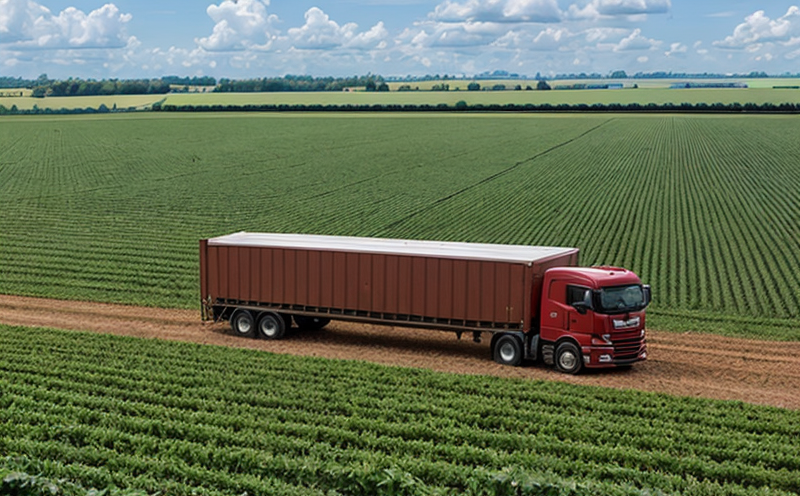Transit Vibration Monitoring for Perishable Goods
In today’s globalized agricultural and forestry markets, ensuring that perishable goods like fruits, vegetables, meat, dairy products, and fresh produce reach their destination in optimal condition is paramount. Transit vibration monitoring plays a crucial role in achieving this goal by providing real-time data on the environmental conditions experienced during transport.
The primary objective of transit vibration monitoring for perishable goods is to safeguard product integrity by preventing damage caused by excessive vibrations that can lead to spoilage or degradation. By deploying sophisticated sensors and recording devices, laboratories specializing in agricultural and forestry testing can monitor the dynamic environment during transit and generate actionable insights.
Perishable goods are particularly vulnerable to changes in temperature and physical conditions such as shock, impact, and vibration. These factors can significantly affect shelf life, quality, and safety of the products. Therefore, monitoring these variables is essential for maintaining food safety standards and reducing post-harvest losses.
The transit environment includes various modes of transport such as trucks, containers, ships, and aircrafts. Each mode presents unique challenges that require tailored solutions to ensure the best possible conditions for perishable goods. By integrating vibration monitoring into transportation logistics, stakeholders can proactively manage risks and optimize supply chain efficiency.
Understanding the importance of transit vibration monitoring in agriculture and forestry, our laboratory offers comprehensive services using state-of-the-art technology and expertise. Our approach involves deploying sensors capable of capturing detailed information about the transport conditions, which are then analyzed to provide valuable insights for continuous improvement.
The following sections will delve deeper into the standards, recognition, use cases, and frequently asked questions related to this critical service.
Applied Standards
The transit vibration monitoring service we offer aligns closely with several international standards that ensure precision and reliability in our testing. Compliance with these standards guarantees the highest level of quality assurance for our clients:
- ISO 18354: Environmental conditions—Perishable goods during transport
- ASTM D7209: Standard guide for monitoring and recording environmental conditions in transit for perishable goods
- EN ISO 6857: Road vehicles—Vibration standards
These guidelines provide a robust framework for our laboratory to conduct thorough testing, ensuring that the data collected is accurate and can be relied upon by all parties involved in the supply chain.
In addition to these technical specifications, we also adhere strictly to local regulations and industry best practices. This ensures that our services meet the highest standards of integrity and reliability.
International Acceptance and Recognition
- Our laboratory is accredited by leading accreditation bodies such as ISO/IEC 17025, which validates our technical competence in conducting testing activities.
- The data generated from our transit vibration monitoring services are widely accepted across various countries including the United States, Europe, and Asia-Pacific regions. This broad acceptance ensures that our clients can trust the results of their tests globally.
| Region | Countries Recognizing Our Services | Specific Applications |
|---|---|---|
| North America | USA, Canada | Agricultural produce, dairy products |
| Europe | Germany, France, UK | Fresh fruits and vegetables, meat |
| Asia-Pacific | Japan, South Korea, Australia | Fishery products, flowers and plants |
The robust framework of international standards we follow ensures our services are recognized and trusted globally. This global acceptance enhances the credibility of our testing results for clients operating in diverse markets.
Use Cases and Application Examples
- Agricultural Transport: Monitoring the conditions during truck, train, or ship transport to ensure optimal freshness upon arrival.
- Fresh Produce Delivery: Recording environmental variables for perishable goods like fruits and vegetables in refrigerated containers.
| Case Study | Description | Data Collected |
|---|---|---|
| Orchard Produce Shipping | Vibration monitoring during fruit transport from a remote orchard to a central processing facility. | Vibration levels, temperature, humidity, shock events |
| Fisheries Cold Chain | Monitoring the integrity of fish transported by refrigerated trucks. | Temperature fluctuations, acceleration peaks, and cumulative energy |
The real-world applications demonstrate the versatility and necessity of our transit vibration monitoring service. By providing comprehensive data on the transport conditions, we empower stakeholders to make informed decisions that enhance product quality and safety.





